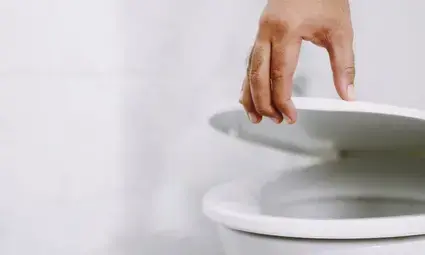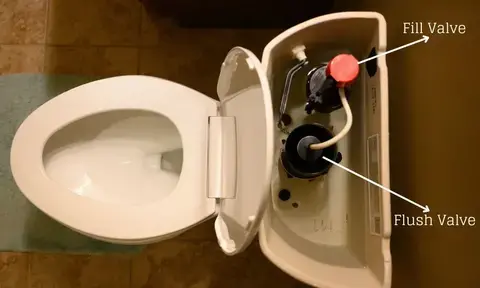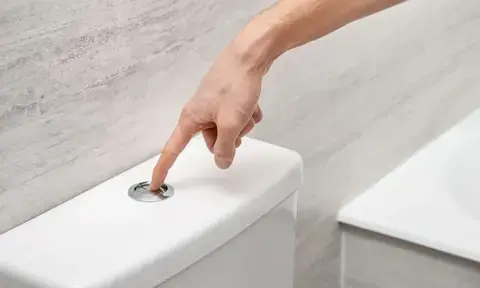
It’s no secret that your bathroom is a cesspool of germs.
Thankfully, all the places in your bathroom are not the same. But one of the most prominent breeding grounds for germs is the toilet, especially when it’s flushed.
Research has shown that each time you flush the toilet, a fine aerosol plume containing microscopic particles replete with harmful germs is thrown upwards.
These aerosol droplets linger in the air for several minutes. As a result, when one person in a family has a bowel infection, the chances of other family members getting infected are high.
But despite being at a higher risk of getting infected by various diseases, most people are unaware of whether they should close the lid before flushing the toilet.
- How Does the Flushing System in a Toilet Work?
- What You Need to Know About Toilet Plume Aerosols?
- Should You Close the Toilet Lid Before Flushing?
- What’s More Important: Washing Your Hands and Cleaning the Bathroom Regularly
Navigate to any section of this post by clicking on the links above.
How Does the Flushing System in a Toilet Work?

The mechanism of the flushing system in a toilet is simple.
The main component is the toilet cistern – a small tank – that stores water used for flushing.
Inside the cistern are two valves: the water fill valve and the toilet flush valve.
The function of the fill valve is to fill the tank with water when it’s empty. The function of the toilet flush valve is to rush water from the tank into the toilet bowl.
In a typical flush cycle, water from the cistern comes into forceful contact with the contents inside the bowl, pushing it down into the drainpipe.
The forceful flushing creates a spray of invisible fecal and urine particles to be suspended in the air around the toilet bowl. The sprayed microscopic particles/droplets are called aerosol plumes.
What You Need to Know About Toilet Plume Aerosols?
Aerosol plumes are typically invisible to the naked eye. But when illuminated by green lasers, a toilet plume shows up like a shower of confetti at a party.
Toilet plume aerosols consist of tiny water droplets or whatever else might be in the toilet bowl.
The main detail you need to know about these aerosols is that they could contain microscopic pathogens such as adenoviruses, noroviruses, C. difficile, and E. coli. Also, there’s a chance that these pathogens will spread out across the bathroom and transmit serious infections.
Adenoviruses cause infections of the intestines, urinary tract, lungs, and eyes. Noroviruses are highly contagious and are transmitted through vomit and feces.
C. difficile causes colitis (inflammation of the colon) and diarrhea. While the majority of E. coli strains are harmless, some strains can cause urinary tract infections, diarrhea, respiratory illness, and pneumonia.
Evidently, the most considerable toilet plume risk happens when one person in the family is ill. The illness can quickly spread to other family members due to exposure to the disease-causing germs in the bathroom.
The most effective way to restrict toilet plume aerosols to the toilet bowl is by closing the toilet lid before flushing.
Should You Close the Toilet Lid Before Flushing?

A clear understanding of how the flushing system of a toilet works will convince you of the importance of closing the toilet lid before flushing.
The flushing system is designed to push the contents of the bowl forcefully into the drainpipe through a downward motion. However, the high pressure generated during the flush cycle also throws up a fine spray of microscopic particles in the air.
These particles will easily spread if you don’t close the toilet lid before flushing. Some of these particles are shot up to 5ft and linger in the air for several minutes.
They can zoom directly into your face, settle on your skin, or even land on various objects – such as your toothbrush, shaving razor, and towel – inside the bathroom.
Aerosolised particles will linger a long time in a poorly ventilated bathroom, increasing the risk of exposure to infection.
Closing the toilet lid before flushing can curb the spread of aerosolised microbes. Hence, you must make a conscious effort to close the toilet lid before flushing since it would be a good habit to get into.
What’s More Important: Washing Your Hands and Cleaning the Bathroom Regularly

Closing the toilet lid before flushing will, doubtless, prevent aerosolised microbes from being sprinkled throughout your bathroom.
However, the primary way that people get sick from the germs in faeces is the hand-to-oral route.
Hence, washing your hands and cleaning your bathroom regularly are even more important.
Deep cleaning your bathroom regularly will help you keep it hygienic all the time.
The potential for faecal-oral transmission of germs is high, especially due to contact with high-touch surfaces, such as doorknobs and taps. Therefore, you must wash your hands after using the toilet.
You can reduce the possibility of getting sick from germs lurking in your toilet bowl or bathroom countertop by making it a habit to wash your hands each time you go to the bathroom. It’s also best to avoid touching your face and mouth needlessly in daily life.
Shop Toilet Seats
At Bathroom City, we’ve got the best toilet seats – from premium to affordable. Your choices are truly endless – from round, elongated, and rectangular options to modern and traditional toilet styles.
Upgrade your toilet today and minimise germs in your bathroom.
Other related articles you might also like to read: